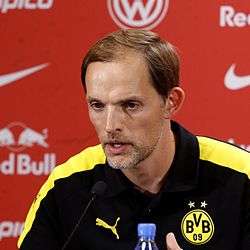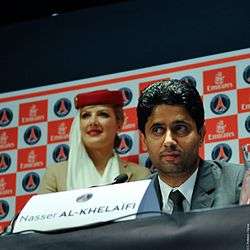Paris Saint-Germain F.C.
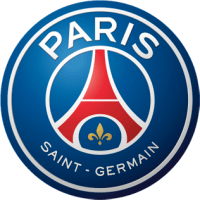 | |||
| Full name | Paris Saint-Germain Football Club | ||
|---|---|---|---|
| Nickname(s) |
| ||
| Short name | PSG, Paris SG | ||
| Founded | 12 August 1970 | ||
| Ground | Parc des Princes | ||
| Capacity | 47,929 | ||
| Owner | Oryx Qatar Sports Investments (QSi) | ||
| President | Nasser Al-Khelaifi | ||
| Manager | Thomas Tuchel | ||
| League | Ligue 1 | ||
| 2017–18 | Ligue 1, 1st | ||
| Website | Club website | ||
|
| |||
| Departments of Paris Saint-Germain | ||
|---|---|---|
| Football (Men's) | Football (Youth Men's) | Football (Women's) |
| Handball (Men's) | eSports | Boxing (Men's) |
| League (Men's) | ||
Paris Saint-Germain Football Club (French pronunciation: [paʁi sɛ̃ ʒɛʁmɛ̃]), commonly known as Paris Saint-Germain, Paris SG, or simply PSG, is a French professional football club based in the city of Paris. Founded in 1970, the club has traditionally worn red and blue kits. The team has played its home matches in the 47,929-capacity Parc des Princes in the 16th arrondissement of Paris since 1974.[1][2] The club plays in the highest tier of French football, Ligue 1.[3]
Paris Saint-Germain established itself as a major force in France, and one of the major forces of European football in recent years. PSG have won a total of 38 trophies, making it the most successful French club in history by this measure.[3][4] PSG is also the only club to have never been relegated from Ligue 1,[5] the club with most consecutive seasons in the top-flight (they have played 45 seasons in Ligue 1 since 1974),[6] one of only two French clubs to have won a major European title,[7] and the most popular football club in France and one of the most widely supported teams in the world.[8]
Domestically, the Parisians have won seven Ligue 1 titles, a record twelve Coupe de France, a record eight Coupe de la Ligue, and a joint record eight Trophée des Champions titles. The club has also won one Ligue 2 title. In European football, they have won one UEFA Cup Winners' Cup and one UEFA Intertoto Cup.[4] PSG have a long-standing rivalry with Olympique de Marseille. The duo contest French football's most notorious match, known as Le Classique.[9]
Oryx Qatar Sports Investments (QSi) have been the club's owner since 2011.[10] The takeover made PSG the richest club in France and one of the wealthiest in the world.[11] Currently, they have the seventh-highest revenue in the footballing world with an annual revenue of €486.2m,[12] and are the world's eleventh most valuable football club, worth €825m.[13] The capital club currently has active departments for youth football (PSG Academy),[14] and women's football (PSG Women).[15]
History
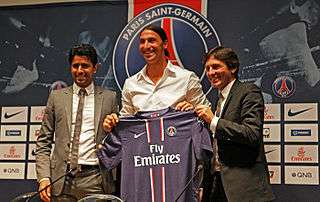
Paris Saint-Germain was formed on 12 August 1970 after the fusion of Paris FC – created a year earlier to fill the void of having no top-flight club in the capital – and Stade Saint-Germain, founded in 1904 in Saint-Germain-en-Laye, the birth town of Louis XIV.[3]
However, PSG really took flight in 1973, when fashion designer Daniel Hechter took over the club. Coached by French football legend Just Fontaine, PSG won promotion to Ligue 1 a year later and slowly began attracting the first stars of PSG such as Mustapha Dahleb and Carlos Bianchi.[3]
In 1978, Daniel Hechter handed control of the club to Francis Borelli, under whose guidance PSG won their first silverware: the Coupe de France in 1982 and 1983 and the league in 1986, during a decade marked by players such as Safet Sušić, Luis Fernández and Dominique Rocheteau.[3]
Canal+ took over the club in 1991, and propelled PSG to the forefront of the European game. Between 1993 and 1997, the club from the French capital made five European semi-finals in a row. Led by football icons David Ginola, George Weah and Valdo, amongst others, PSG won a second league title in 1994, two years before lifting the UEFA Cup Winners' Cup.[3]
At the start of the 21st century, PSG produced many talents, including Ronaldinho and Pauleta, but struggled to rescale the heights they obtained during the earlier years. This changed in 2011, however, with the arrival of new owners Oryx Qatar Sports Investments (QSi), and new club president Nasser Al-Khelaifi. QSi established an extremely ambitious project to take the club to the summits of the European game.[3]
Spearheaded by the arrival of superstar striker Zlatan Ibrahimović, PSG attained four league titles, three Coupe de France, four Coupe de la Ligue and five Trophée des Champions titles.[3] The club further built upon this success by signing world-record transfer Neymar and 18-year-old French prodigy Kylian Mbappé in 2017.[16][17] Together with Uruguayan striker Edinson Cavani,[18] they formed a fearsome attacking trio and claimed PSG's third domestic quadruple in four seasons.[19][20]
Club identity
Colours
Since its foundation, PSG have always represented both Paris and Saint-Germain-en-Laye.[21] As a result, red, blue and white are the traditional colours of Paris Saint-Germain. The red and blue represent the city of Paris, while the white stands for the nearby commune of Saint-Germain-en-Laye.[22]
In the club's crest, the French capital is represented by the Eiffel Tower in red and the blue background. For its part, the white cradle with the white fleur de lys on top is a hint to the coat of arms of Saint-Germain-en-Laye and to French royalty. In France, white is the colour of royalty and the fleur de lys is a royal symbol. The cradle and the fleur de lys also recall that French King Louis XIV was born in Saint-Germain-en-Laye in 1638.[22]
Likewise, PSG's home shirt has always featured the three colours of the club. The three main home jerseys worn by Paris SG throughout its history have been predominantly red, blue or white. The club's first shirt was red, while the other two were predominantly blue (« Hechter shirt ») and white. However, all three have included the remaining two colours, as well as with further variations of the home jersey.[23]
Home shirt
The newly formed Paris Saint-Germain wore a red shirt during its first three seasons of existence.[23] The jersey also featured a blue and white collar to bring together the three colours of the club: the red and blue of Paris, and the white of Saint-Germain-en-Laye.[24] During the 2010–11 season, PSG wore a red shirt in their home games to commemorate its 40th anniversary.[25]
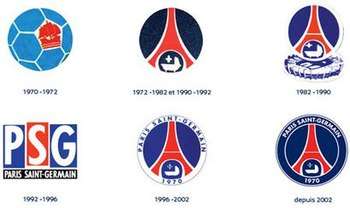
In 1973, fashion designer Daniel Hechter became club president and designed PSG's iconic jersey. Hechter would later admit that his creation was influenced by Ajax's outfit.[26] The so-called "Hechter shirt", first worn until 1980–81, is blue with a red central and vertical band framed by white edgings.[26][27] It returned as PSG's home identity in 1994–95, and has remained so ever since, despite Nike's constant innovations.[27][23]
PSG stars from the 1990s and 2000s eras such as Raí, Ronaldinho and Pauleta are associated with the blue-white-red-white-blue shirt. It was with the "Hechter shirt" that PSG reached five European semi-finals in a row (1993–1997), claimed the UEFA Cup Winners' Cup in 1995–96, and achieved the (first) eight consecutive wins against Olympique de Marseille (2002–2004).[23]
Promoted by PSG president Francis Borelli, the capital club changed its home identity in 1981–82.[26] The new shirt, worn until 1992–93, was white with blue and red vertical stripes on the left. PSG legends from the 1980s like Safet Sušić, Luis Fernández and Dominique Bathenay are associated with the white jersey. It was with this outfit that fans saw the first big Paris Saint-Germain team that won two Coupe de France titles (1982, 1983), experienced its first European campaign in 1983, and claimed its maiden league crown in 1986.[27][23]
Crest
The first crest of the club, also known as the Paris FC logo, was used from 1970 until 1973.[24] It featured a ball and a vessel, two powerful symbols of Paris, as well as the club's name "Paris Saint Germain Football Club" or its initials "PSGFC".[28] In 1972, PSG split from Paris FC and, a year later, the club changed its crest.[28]
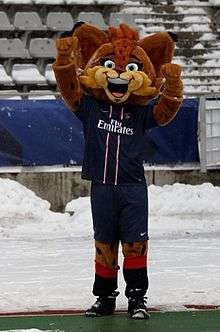
PSG presented their historic crest in 1973, known as the Eiffel Tower logo.[28] The new logo finally represented both Paris and Saint-Germain-en-Laye. It mainly consisted of a blue background with the Eiffel Tower in red. But between the tower's legs sat two Saint-Germain-en-Laye symbols in white: Louis XIV's cradle and a fleur de lys.[28] According to former PSG manager Robert Vicot, club president Daniel Hechter introduced the Eiffel Tower in the crest. However, it was a draftsman called Mr. Vallot who had the idea of placing the birthplace of Louis XIV between the legs of the tower.[29]
In 1980, the Parc des Princes was added to the crest, right under Louis XIV's cradle.[28] This logo lasted until 1991, with the exception of the 1986–87 and 1987–88 seasons, when the club used a special logo in support of the Paris candidature for the 1992 Summer Olympics.[28][30] In 1991, the Parc des Princes was removed from the crest.[28]
In 1993, former Paris SG shareholder Canal+ was the first to replace the iconic crest. The new model had the acronym "PSG" and underneath it "Paris Saint-Germain". Under pressure from supporters, the traditional crest returned in 1995. This time, however, the crest was surrounded by the club's name "Paris Saint-Germain" and its year of foundation "1970". In 2002, it went through a slight facelift.[28]
In 2013, the Eiffel Tower crest received a major makeover. PSG shareholder Oryx Qatar Sports Investments (QSi) wanted to take full advantage of the city's global appeal and the new crest features the name "PARIS" written in large bold letters. Additionally, Louis XIV's cradle was left out as the fleur de lys now sits solely under the Eiffel Tower. Finally, "Saint-Germain" took the place of the club's founding year "1970" at the bottom.[31]
Mottos, mascot and anthems
"Paris est magique!" ("Paris is magic!") and "Ici, c'est Paris!" ("Here is Paris!") have historically been the club's most popular mottos.[32][33] More recently, PSG introduced its official anthem and mascot. In commemoration of its 40th anniversary in 2010, the capital club revived its Tournoi de Paris pre-season competition.[34]
Ahead of the tournament, PSG unveiled "Allez Paris Saint-Germain", to the tune of "Go West" by Village People, and Germain the Lynx as the club's anthem and mascot, respectively.[35] "Ville Lumière", to the tune of "Flower of Scotland", is considered a club anthem as well.[36]
Grounds
Parc des Princes
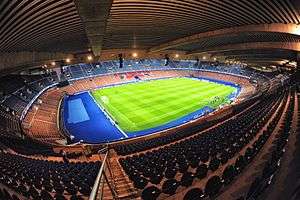
The Parc des Princes is an all-seater football stadium in Paris, France.[37] The venue is located in the south-west of the French capital,[38] inside the 16th arrondissement of Paris, in the immediate vicinity of the Stade Jean-Bouin (rugby venue) and within walking distance from the Stade Roland Garros (tennis venue).[37]
The stadium, with a seating capacity of 47,929 spectators,[1] has been the home pitch of Paris Saint-Germain since 1974. Before the opening of the Stade de France in 1998, it was also the home arena of the French national football and rugby union teams.[39] The Parc des Princes pitch is surrounded by four covered all-seater stands, officially known as the Présidentielle Francis Borelli, Auteuil, Paris and Boulogne Stands.[40]
Conceived by architect Roger Taillibert, the current version of the Parc des Princes officially opened on 4 June 1972,[21] at a cost of 80–150 million francs.[41] The stadium is the third to have been built on the site, the first opening its doors in 1897 and the second following in 1932.[38]
PSG registered its record home attendance in 1983, when 49,575 spectators witnessed the club's 2–0 win over Waterschei in the UEFA Cup Winners' Cup quarter-finals.[42] However, the French national rugby team holds the stadium's absolute attendance record. They defeated Wales 31–12 in the 1989 Five Nations Championship in front of 50,370 spectators.[43]
Camp des Loges
The Camp des Loges, also known as the Ooredoo Training Centre for sponsorship reasons,[44] is a sports complex located in Saint-Germain-en-Laye.[45] The current version of the Camp des Loges officially opened on 4 November 2008.[46] It is the second to have been built on the site, the first opening its doors in 1904.[45]
The sports complex has been the training centre of Paris Saint-Germain since the club's foundation in 1970, as well as playing host to the Paris Saint-Germain Academy since its opening on 4 November 1975.[45] In July 2016, PSG chose Poissy as the site of its future performance centre, baptised Campus Paris Saint-Germain, which is scheduled to open at the start of the 2019–20 season.[47][48]
Stade Municipal Georges Lefèvre
The Stade Municipal Georges Lefèvre is a sports complex located on Président-Kennedy avenue in the forest of Saint-Germain-en-Laye, just across the street from Paris Saint-Germain's training centre, the Camp des Loges.[49]
The complex's main football stadium, with a seating capacity of 2,164 spectators,[49] was the home pitch of PSG until 1974,[50] when the club moved into the Parc des Princes.[2] Currently, the stadium — as well as the other artificial turf and grass football pitches of the complex — hosts training sessions and home matches for the Paris Saint-Germain Academy.[49]
Support
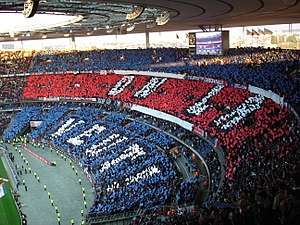
Paris Saint-Germain is the most popular football club in France ahead of arch-rivals Olympique de Marseille.[8] Former French President Nicolas Sarkozy is one of the club's most prominent supporters.[32] Since the emergence of the Boulogne Boys in the 1980s, PSG fan groups or ultras have been linked to football hooliganism.[51] PSG's Boulogne Boys, considered one of the oldest hooligan groups in France,[52] took their British neighbours as dubious role models and violence escalated in the early 1990s. PSG owners Canal+, France's premium pay channel, even tried to break up the Boys without success.[51]
That's why they encouraged some non-violent fans of Boulogne to take place in the Virage Auteuil at the other end of Boulogne Boys. In order to be differentiated with Boys, Supras Auteuil followed Italian supporters' example with the use of flares and tifo choreography. More generally, this distinction is also a representation of the state of Paris in the 1990s with Boulogne Boys embodying skinhead subculture and French far-right movements, and Supras Auteuil representing Parisian diversity with immigrants or sons of immigrants[53]. However, as the years go by, there was less xenophobia in Boulogne even if nationalism was still present.
The feared French riot police were expelled by the Boys and other minor fan groups in the Boulogne stand during a game against Caen in 1993. Incidents occurred wherever PSG travelled, and only multiplied with the emergence of the Supras Auteuil in the Auteuil stand as a rival to Boulogne's hegemony.[51] Things came to a head in February 2010 shortly after Marseille beat PSG 3–0 at Parc des Princes.[54] PSG supporter Yann Lorence was involved in a violent exchange outside the Parc des Princes between the Boulogne Boys and their counterparts in the Auteuil stand at the other end of the stadium.[51] The 37-year-old was left in a critical condition and hospitalised but was pronounced clinically dead the following month because of the injuries he sustained that night. Lorence's death forced then PSG president Robin Leproux to take action. All season tickets at Parc des Princes were revoked and all ultra groups were exiled in what was known as "Plan Leproux."[54] The incident led to the dissolution of the Supras Auteuil.[55]
The death of Yann Lorence was not even the first in recent memory. Julien Quemener, a Boulogne Boys member, was shot dead by an off-duty policeman during violence following PSG's UEFA Cup tie with Hapoel Tel Aviv in November 2006.[51] During the 2008 Coupe de la Ligue Final, the Boys also unfurled a banner which referred to Lens fans as incestuous, jobless paedophiles. The episode led to the dissolution of the Boulogne Boys.[52] Before "Plan Leproux" came into effect, Parc des Princes was one of the most intimidating stadiums to visit in Europe.[54] The plan made PSG pay the price in terms of atmosphere, with one of Ligue 1's most feared venues now subdued.[51] For their part, many of the remaining supporter groups formed the Collectif Ultras Paris (Paris Ultras Collective or CUP) with the aim of returning to the Parc des Princes.[54]
In early October 2016, after a six-year absence, the club and the CUP first agreed a Parc des Princes return for PSG's 2–0 home win over Bordeaux. The ultras have since been regrouped in the Auteuil end of the stadium.[54] In April 2017, PSG's ultras reportedly damaged areas of Lyon's Parc OL during the 2017 Coupe de la Ligue Final against Monaco. As a result, the French Football League (LFP) hit PSG with a €100,000 fine.[56] In May 2017, PSG supporter groups Lista Nera Paris and Microbes Paris left the CUP. Additionally, the CUP dismissed the Karsud group from its ranks. The groups left in the CUP are the K-Soce Team, Liberte pour les Abonnes, Le Combat Continue, Le Parias and Nautecia.[57] In August 2017, PSG and the CUP reached an agreement to allow the club's Ultras to hold season tickets together in the Auteuil end for the first time since 2010.[58]
Rivalries
Paris Saint-Germain shares an intense rivalry with Olympique de Marseille; matches between the two teams are referred to as Le Classique.[59] The clash is considered France's biggest rivalry,[9][59][60][61][62][63][64] and one of the greatest in club football.[9][62][65][66][67][68][69] At the very least, it is France's most violent. Important security measures are taken to prevent confrontations between the fans, but violent episodes still often occur when the duo meet.[59]
PSG and l'OM remain, along with Saint-Étienne, the only French clubs with a big history pre-millennium. The duo are the only two French clubs to have won major European trophies and were the dominant forces in the land prior to the emergence of Olympique Lyonnais at the start of the millennium. They are also the two most popular clubs in France, and the most followed French clubs outside the country. Both teams are at or near the top of the attendance lists every year as well.[59][9]
Like all the game's major rivalries, PSG vs. OM extends beyond the pitch. The fixture has a historical, cultural and social importance that makes it more than just a football match. It involves the two largest cities in France: Paris against Marseille, capital against province and north against south.[59][9]
Friendly tournaments
Tournoi de Paris
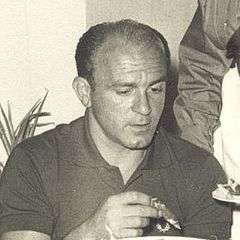
The Tournoi de Paris, also known as Trophée de Paris, was a pre-season association football invitational competition hosted by Paris Saint-Germain at the Parc des Princes. The competition was founded in 1957 by former hosts Racing Paris to celebrate their 25th anniversary.[70] The inaugural 1957 edition is considered a precursor of both the Intercontinental Cup and FIFA Club World Cup, and its final match, between Brazilian team Vasco da Gama and current European champions Real Madrid, was dubbed by newspapers as "Europe's best team vs. South America's best team". The tournament in the French capital prompted the creation of the Intercontinental Cup in 1960 as an official, UEFA/CONMEBOL-endorsed European/South American club contest.[71]
Regarded as French football's most prestigious friendly tournament, the Tournoi de Paris was initially held by Racing Paris between 1957 and 1966.[70][72] It briefly returned in 1973 with new hosts Paris FC, before current hosts Paris Saint-Germain successfully relaunched the competition in 1975.[70][72] Abandoned in 1993 for financial reasons, PSG revived the Tournoi de Paris in 2010 to commemorate its 40th anniversary.[73][34] Ahead of the tournament, PSG introduced its official anthem and mascot.[35] Not held in 2011, it was renamed Trophée de Paris in 2012, and featured a single prestigious match. This was the tournament's last edition to date.[74]
Since its inception, the winners have received different trophies.[70][75] Vasco da Gama won the inaugural Tournoi de Paris in 1957, while Barcelona won the last edition in 2012.[70][74] Paris Saint-Germain is the most successful club in the competition's history, having lifted the trophy on seven occasions.[70] Belgian outfit Anderlecht is next on the title count with three, while fellow French club Racing Paris and Brazilian sides Santos and Fluminense are the only other teams to have won the competition more than once. PSG arch-rivals Olympique de Marseille is among a group of clubs to have won the tournament once.[76]
Tournoi Indoor de Paris-Bercy
The Tournoi Indoor de Paris-Bercy was a mid-season indoor football invitational competition hosted by Paris Saint-Germain at the AccorHotels Arena in Paris, France. The tournament was founded in 1984 and was held annually until 1991. Played indoors (synthetic field and seven-a-side), the competition featured host club PSG and five more teams.[77]
1983 European champions Hamburger won the inaugural 1984 edition, which also featured hosts Paris SG, French clubs Monaco and Bordeaux, Brazilian team Fluminense and Algerian side Tizi Ouzou (currently named JS Kabylie). Ukrainian club Dynamo Kyiv, for its part, won the tournament's last edition in 1991.[77]
Paris Saint-Germain is the most successful club in the competition's history, despite failing to win it until the 4th edition. The Parisians lifted the trophy on two occasions (1987 and 1990), thus becoming the only club to have won the tournament more than once. Besides Hamburger and Dynamo Kyiv, German side Köln, Belgian outfit Anderlecht, Brazilian team Santos and Dutch club Ajax also won the competition once.[77]
Ownership and finances
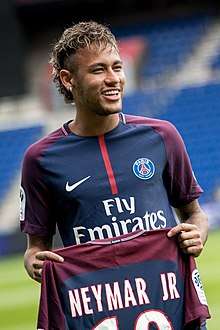
Paris Saint-Germain are today the city's largest club by far.[7] Currently, they have the sixth-highest revenue in the footballing world with an annual revenue of €486.2m,[12] and are the world's eleventh most valuable football club, worth €775m.[78] Throughout its history, though, the club has rarely been profitable.[79]
Supported by a group of wealthy businessmen, as well as the capital's media and 20,000 subscribers, the club grew quickly.[3][50] However, in 1972 the club split into two. One branch continued in Ligue 1 under the name of Paris FC, while PSG assumed amateur status and had to restart in Division 3.[5] PSG really took flight in 1973, when fashion designer Daniel Hechter took over the club.[3] A year later, PSG returned to Ligue 1.[5]
In January 1978, Hechter was banned for life from football by the French Football Federation following a double ticketing scandal at the Parc des Princes.[80] Francis Borelli replaced him as PSG president and the club's first trophies arrived. However, competition for recognition as the capital's No1 sporting entity came from Matra Racing between 1984 and 1989, and PSG went into decline.[7]
Canal+'s takeover in 1991 revitalised the club with star signings (Valdo, David Ginola, George Weah, Raí, Youri Djorkaeff) that ensured several trophies (most notably the UEFA Cup Winners' Cup in 1996).[7] However, PSG's form slowly declined and eventually, a split from owners Canal+ became inevitable.[50] In 2006, Canal+ sold PSG to investment firms Colony NorthStar, Butler Capital Partners and Morgan Stanley for €41m.[81] In 2009, Colony bought out Morgan's shares to become 95% owners, with Butler retaining a 5% stake in the club.[82]
Stability finally came back to PSG in 2011, when the club was purchased by Oryx Qatar Sports Investments after two solid years under president Robin Leproux.[7][50] QSi bought a controlling 70% of the shares and became the majority shareholder of PSG. Colony (29%) and Butler (1%) remained minority shareholders.[10] The deal, worth €50m, covered €15–20m in debt and €19m in losses from the 2010–11 season.[83] QSi chairman Nasser Al-Khelaifi became PSG's new president.[83][84] In 2012, QSi purchased the remaining 30% stake for €30m to become the club's sole shareholder.[10] Prior to the Qatar buyout PSG had recorded losses for over a decade. The year before, the club recorded a loss of $37m.[79]
The takeover made Paris Saint-Germain not only the richest club in France but one of the wealthiest in the world.[11] QSi pledged to form a team capable of winning the UEFA Champions League and making the club France's biggest name.[50] Big money signings Thiago Silva, Zlatan Ibrahimović, Edinson Cavani and David Luiz arrived in the club, though not without consequences.[7] In May 2014, UEFA punished PSG for violating Financial Fair Play (FFP) rules. Most notably, FFP sanctions included a €60m fine, amongst other sporting and financial measures.[85] In September 2015, UEFA lifted the restrictions imposed on the Parisian club.[86]
In August 2017, the capital club activated the €222m release clause of Barcelona player Neymar, making him the most expensive transfer in football history.[16] Later that month, PSG signed Kylian Mbappé from AS Monaco on loan with an option to buy for €180m that made him the second-most expensive player in the world.[17] As a result, UEFA opened a new FFP investigation into PSG.[87] In June 2018, UEFA cleared the club of breaching financial fair play rules.[88] A month later, however, UEFA’s Club Financial Control Body (CFCB) announced it would review its decision.[89]
Sponsors, partners and suppliers
Currently, the club's top sponsors are American sports brand Nike, Dubai-based airline Emirates, Qatari commercial bank QNB Group and international telecommunications company Ooredoo. Meanwhile, official partners include global network of sports channels beIN Sports, French automobile manufacturer Renault, French telecommunications corporation Orange and Swedish telecommunications company Ericsson. And, finally, PSG's official suppliers are McDonald's, Nivea, Coca-Cola, Achilles Radial, EA Sports, Chronopost, Hugo Boss, Boulanger, Richard Mille, MAN, Technogym, Beats Electronics, Isilines, Go Sport, Unibet and American Express.[90]
French sportswear manufacturer Le Coq Sportif has been the kit supplier of Paris Saint-Germain in three occasions: from 1970 until 1975; then, during the 1976–1977 season; and, finally, from 1978 to 1986.[91] In between, German sports multinational Adidas, Kopa — French footballer Raymond Kopa's short-lived sportswear brand — and American company Pony briefly took charge of the club's kits. Adidas and Kopa acted as joint suppliers for the 1975–1976 campaign, while Pony and Kopa did so during the 1977–78 season.[24]
In 1986, Adidas returned as the club's kit manufacturer. The partnership lasted until 1989, when PSG signed with Nike.[24] Since the end of its contract with Adidas, until today, Nike has been PSG's shirt supplier.[91] In December 2013, Nike announced the renewal of its partnership with PSG that began from the start of 2014–15 season and will run until at least the 2021–22 campaign. Nike and Paris Saint-Germain have been partners since the 1989–90 season.[92]
PSG's first shirt sponsor was Montreal (1972–1973).[93] The club was then sponsored by Canada Dry (1973–1974),[24] before a long-term deal with RTL (1974–1991).[94][26] PSG was subsequently sponsored by Commodore (1991–1994),[27] SEAT (1994–1995),[27] Opel (1995–2002),[95] and Thomson (2002–2006).[96] PSG's current shirt sponsor is Emirates. Paris Saint-Germain and Emirates have been partners since 2006.[97]
Records and statistics
Since its inception, Paris Saint-Germain have played 48 seasons, all of which have been spent within the first three levels of the French football league system (Ligue 1, Ligue 2 and Division 3).[4] PSG holds many records, most notably being the most successful French club in history in terms of trophies won, with 38,[3][4] the only club to have never been relegated from Ligue 1,[5] the club with most consecutive seasons in top-flight (they have played 45 seasons in Ligue 1 since 1974),[6] and one of only two French clubs to have won a major European title.[7]
The Parisians have won the Ligue 1 seven times. The club's worst Ligue 1 finish to date is 16th, their placing at the end of the 1971–72 and 2007–08 seasons.[4] The 2015–16 season was the club's best to date. PSG won all four domestic titles (Ligue 1, Coupe de France, Coupe de la Ligue and Trophée des Champions) and reached the quarter-finals of the UEFA Champions League.[4] In Ligue 1, the capital club finished with 96 points (national record),[98] while Zlatan Ibrahimović scored 50 goals in all competitions (national record).[99] However, the club's record for most goals in a season was set in 2017–18, when the capital side scored 171 goals in all competitions.[98]
Paris SG are also the only club to have won the Coupe de la Ligue five times in a row (2014–2018),[100] the only club to have won the Coupe de France four times in a row (2015–2018),[101] one of only two clubs to win the Trophée des Champions six times in a row (2013–2018),[102] the only European club to have won all four national titles (Ligue 1, Coupe de France, Coupe de la Ligue and Trophée des Champions) in a single season (2014–15, 2015–16 and 2017–18),[103] the only club to have won the Coupe de France without conceding a single goal (1992–93 and 2016–17),[104] and the youngest European club to have won a European trophy.[105]
Honours
- As of the 2018–19 season.[4]
| Type | Competition | Titles | Seasons |
|---|---|---|---|
| Domestic | Ligue 1 | 7 | 1985–86, 1993–94, 2012–13, 2013–14, 2014–15, 2015–16, 2017–18 |
| Ligue 2 | 1 | 1970–71 | |
| Coupe de France | 12 | 1981–82, 1982–83, 1992–93, 1994–95, 1997–98, 2003–04, 2005–06, 2009–10, 2014–15, 2015–16, 2016–17, 2017–18 | |
| Coupe de la Ligue | 8 | 1994–95, 1997–98, 2007–08, 2013–14, 2014–15, 2015–16, 2016–17, 2017–18 | |
| Trophée des Champions | 8 | 1995, 1998, 2013, 2014, 2015, 2016, 2017, 2018 | |
| European | UEFA Cup Winners' Cup | 1 | 1995–96 |
| UEFA Intertoto Cup | 1 | 2001 | |
Players
- As of the 2018–19 season.[106]
Current squad
Note: Flags indicate national team as defined under FIFA eligibility rules. Players may hold more than one non-FIFA nationality.
|
|
Out on loan
Note: Flags indicate national team as defined under FIFA eligibility rules. Players may hold more than one non-FIFA nationality.
|
|
Former players
Hall of Fame
In July 2017, the club announced its "Hall of Fame" of notable players.[107] The inaugural induction saw 20 former players named, including record appearance maker Jean-Marc Pilorget,[108] all-time assist leader Safet Sušić,[109] longest-serving captain Dominique Bathenay,[110] and Ballon d'Or winner George Weah.[111]
Officials
Technical staff
| Manager | Thomas Tuchel |
| Assistant managers | Arno Michels Zsolt Lőw Zoumana Camara |
| Goalkeeping coach | Gianluca Spinelli |
| Physical trainers | Rainer Schrey Denis Lefebve Nicolas Mayer |
Source:Footballdatabase.eu
Board members
| President | Nasser Al-Khelaifi |
| General Manager | Jean-Claude Blanc |
| Sporting director | Antero Henrique |
| Sports coordinator | Maxwell |
| Academy director | Jean-François Pien |
Source:Footballdatabase.eu
References
- 1 2 "Parc des Princes". PSG.fr. Archived from the original on 19 August 2017. Retrieved 19 July 2017.
- 1 2 "Paris Saint-Germain FC". UEFA.com. 19 June 2013. Archived from the original on 3 September 2014. Retrieved 18 June 2014.
- 1 2 3 4 5 6 7 8 9 10 11 "Histoire". PSG.fr. Archived from the original on 19 August 2017. Retrieved 17 July 2017.
- 1 2 3 4 5 6 7 "Paris S-G: Histoire du club dans chaque compétition". Footballdatabase.eu. Retrieved 2 March 2017.
- 1 2 3 4 "Which European football clubs have never been relegated?". The Guardian. 2 June 2015. Archived from the original on 2 February 2017. Retrieved 24 January 2017.
- 1 2 "PSG, 45 saisons consécutives et nouveau record en Ligue 1". Histoire du #PSG. 11 August 2018. Retrieved 11 August 2018.
- 1 2 3 4 5 6 7 "Paris city guide". UEFA.com. Archived from the original on 9 July 2016. Retrieved 4 July 2016.
- 1 2 "C'est une première : les Français préfèrent le PSG à l'OM". Eurosport. 4 October 2015. Archived from the original on 18 April 2017. Retrieved 17 April 2017.
- 1 2 3 4 5 "France's passion play". FIFA.com. Archived from the original on 22 April 2014. Retrieved 25 February 2013.
- 1 2 3 "Le Qatar sans limite". Le Parisien. 7 March 2012. Archived from the original on 6 December 2016. Retrieved 7 March 2012.
- 1 2 "Paris Saint-Germain, having conquered France, are still working on Qatar". The National. 30 December 2015. Archived from the original on 18 April 2017. Retrieved 17 April 2017.
- 1 2 "Deloitte Football Money League 2018". Deloitte. Archived from the original on 22 May 2018. Retrieved 23 January 2018.
- ↑ Ozanian, Mike. "The World's Most Valuable Soccer Teams 2018". Forbes. Retrieved 2018-06-12.
- ↑ "Formation". PSG.fr. Retrieved 3 July 2016.
- ↑ "Stories – Féminines". PSG.fr. Retrieved 3 July 2016.
- 1 2 "Neymar: Paris St-Germain sign Barcelona forward for world record €222 million". BBC Sport. 3 August 2017. Retrieved 8 August 2017.
- 1 2 "Paris Saint-Germain sign 'great talent' Kylian Mbappé on initial loan". The Guardian. 31 August 2017. Retrieved 8 September 2017.
- ↑ "Edinson Cavani joins Paris St-Germain from Napoli for £55m". BBC Sport. 16 July 2013. Retrieved 8 August 2017.
- ↑ "Neymar-Mbappe-Cavani send out a Champions League message". Goal.com. 12 September 2017. Retrieved 1 October 2017.
- ↑ "PSG clinch quadruple with Coupe de France win". Ligue1.com. 8 May 2018. Retrieved 12 May 2018.
- 1 2 "PSG firmly in the pantheon". FIFA.com. 17 October 2008. Archived from the original on 5 October 2015. Retrieved 18 June 2014.
- 1 2 "Le PSG". Saint-Germain-en-Laye. Archived from the original on 6 November 2013. Retrieved 8 July 2013.
- 1 2 3 4 5 "Paris Saint-Germain, la capitale scintille en rouge et bleu". SO FOOT.com. 28 December 2015. Archived from the original on 17 April 2017. Retrieved 10 April 2017.
- 1 2 3 4 5 "Historique des maillots du PSG : les années 1970". PSG MAG. 16 June 2010. Archived from the original on 26 July 2013. Retrieved 8 July 2013.
- ↑ "Historique des maillots du PSG : les années 2010". PSG MAG. 20 June 2010. Retrieved 3 October 2017.
- 1 2 3 4 "Historique des maillots du PSG : les années 1980". PSG MAG. 17 June 2010. Retrieved 3 October 2017.
- 1 2 3 4 5 "Historique des maillots du PSG : les années 1990". PSG MAG. 18 June 2010. Retrieved 3 October 2017.
- 1 2 3 4 5 6 7 8 "Blasons, Logos, Écussons du PSG". PSG70. Archived from the original on 11 November 2011. Retrieved 7 October 2010.
- ↑ "Robert Vicot : " Je suis l'initiateur de l'échauffement collectif "". PSG70. Archived from the original on 20 February 2012. Retrieved 9 May 2013.
- ↑ "Design sporting club: L'OM et le PSG. Une histoire d'amour... du design". Design sporting club. 5 January 2012. Retrieved 9 August 2018.
- ↑ "New identity for Paris Saint-Germain as the club unveils its new crest". 1970 PSG. 22 February 2013. Archived from the original on 27 February 2013. Retrieved 22 April 2013.
- 1 2 "Can Paris Saint-Germain become the world's richest sports club?". Financial Times. 28 March 2014. Archived from the original on 14 July 2015. Retrieved 13 July 2015.
- ↑ "Paris is Earning". The Classical. 11 January 2012. Archived from the original on 31 January 2012. Retrieved 13 February 2012.
- 1 2 "Football – Tournoi de Paris : Bordeaux maître dans la capitale". RTL.fr. 1 August 2010. Archived from the original on 25 February 2017. Retrieved 24 February 2017.
- 1 2 "Le PSG prend un nouveau virage". PSG.fr. 23 July 2010. Archived from the original on 19 August 2017. Retrieved 26 July 2010.
- ↑ "Comment "O Ville Lumière" est en train de pousser Phil Collins vers la sortie". L'ÉQUIPE. 19 December 2015. Archived from the original on 12 April 2016. Retrieved 17 July 2017.
- 1 2 "PARC DES PRINCES". Paris2024. Archived from the original on 15 August 2016. Retrieved 7 July 2016.
- 1 2 "Parc des Princes". UEFA.com. Archived from the original on 3 July 2016. Retrieved 7 July 2016.
- ↑ "The lowdown on the Parc des Princes". Real Madrid CF. 21 October 2015. Archived from the original on 16 August 2016. Retrieved 7 July 2016.
- ↑ "Plan du Parc". PSG.fr. Archived from the original on 3 March 2017. Retrieved 2 March 2017.
- ↑ "Le Parc des Princes". Info PSG. Archived from the original on 21 August 2016. Retrieved 7 July 2016.
- ↑ "PSG-OM, record d'affluence au Parc des Princes en L1". Paris.canal-historique. 24 October 2016. Archived from the original on 23 November 2016. Retrieved 23 November 2016.
- ↑ "Parc des Princes Paris". Stadium and Attendances. Archived from the original on 19 August 2016. Retrieved 7 July 2016.
- ↑ "Ooredoo, nouveau partenaire du Paris Saint-Germain". PSG.fr. 12 September 2013. Archived from the original on 19 August 2017. Retrieved 9 July 2016.
- 1 2 3 "Le Camp des Loges à St-Germain". 78actu. 26 June 2016. Archived from the original on 27 June 2016. Retrieved 9 July 2016.
- ↑ "Présentation du nouveau centre d'entraînement". PSG.fr. 3 November 2008. Archived from the original on 19 August 2017. Retrieved 9 July 2016.
- ↑ "Le Paris Saint-Germain choisit Poissy". PSG.fr. 11 July 2016. Archived from the original on 16 July 2016. Retrieved 12 July 2016.
- ↑ "Présentation du Campus Paris Saint-Germain aux riverains". PSG.fr. 2 June 2017. Archived from the original on 19 August 2017. Retrieved 4 June 2017.
- 1 2 3 "Stade municipal Georges Lefèvre". Saint-Germain-en-Laye. Archived from the original on 19 August 2016. Retrieved 9 July 2016.
- 1 2 3 4 5 "A brief history of PSG". ESPN FC. 17 August 2012. Archived from the original on 12 November 2015. Retrieved 18 June 2014.
- 1 2 3 4 5 6 "Fratricidal turf war threatening PSG future". ESPN FC. 12 October 2010. Archived from the original on 4 November 2014. Retrieved 13 February 2012.
- ↑ "How PSG lost its soul". LookLeft. 1 December 2013. Retrieved 22 September 2018.
- 1 2 3 4 5 "Why the return of Paris Saint-Germain's ultras is such a big deal". ESPN FC. 12 November 2016. Archived from the original on 23 November 2016. Retrieved 22 November 2016.
- ↑ "A League of One". The New York Times. 6 March 2013. Archived from the original on 1 July 2017. Retrieved 13 July 2015.
- ↑ "PSG fined €100,000, threatened with supporters' ban after damage at Lyon". ESPN FC. 28 April 2017. Retrieved 3 October 2017.
- ↑ "Paris Saint-Germain ultras lose two supporter groups". ESPN FC. 9 May 2017. Archived from the original on 11 August 2017. Retrieved 11 August 2017.
- ↑ "Paris Saint-Germain end Ultras season ticket restriction after seven years". ESPN FC. 12 August 2017. Archived from the original on 12 August 2017. Retrieved 12 August 2017.
- 1 2 3 4 5 "Joey Barton puts the "punch" back into the Marseille-PSG rivalry". Bleacher Report. 4 September 2012. Archived from the original on 3 October 2012. Retrieved 29 July 2013.
- ↑ "Marseille vs. PSG, France's awesome made-up rivalry". SBNation.com. 3 April 2015. Retrieved 7 November 2017.
- ↑ "Payet has a chance to shine in France's biggest rivalry". Daily Mail Online. 23 February 2017. Retrieved 7 November 2017.
- 1 2 "Football's greatest rivalries: PSG vs. Marseille". Rob Smith's Football El Mundo. 18 December 2013. Retrieved 7 November 2017.
- ↑ "PSG destroys Marseille 5–1 in French league". USA Today. 26 February 2017. Retrieved 28 February 2017.
- ↑ "PSG vs Olympique de Marsella: Le Classique del fútbol francés". MARCA. 9 November 2017. Retrieved 12 November 2017.
- ↑ "THE LIST: The greatest rivalries in club football". Daily Mail Online. 13 September 2009. Retrieved 28 August 2015.
- ↑ "FourFourTwo's 50 Biggest Derbies in the World". FourFourTwo. 25 April 2016. Retrieved 3 November 2017.
- ↑ "The top 50 football derbies in the world". Mirror Online. 13 October 2017. Retrieved 3 November 2017.
- ↑ "20 of World Football's Greatest Rivalries". Bleacher Report. 2 October 2015. Retrieved 3 November 2017.
- ↑ "Más que un partido: Los 20 clásicos más importantes del fútbol mundial". MARCA. 8 November 2017. Retrieved 12 November 2017.
- 1 2 3 4 5 6 "Anecdotes autour du Tournoi de Paris". PSG.fr. 12 July 2010. Archived from the original on 19 August 2017. Retrieved 23 January 2011.
- ↑ "Há 60 anos, Vasco derrotava o Real Madrid de Di Stéfano em Paris". Globo Esporte. 14 June 2017. Retrieved 4 November 2017.
- 1 2 "Le Paris SG va relancer le Tournoi de Paris en juillet". Le Point. 24 December 2009. Archived from the original on 26 December 2009. Retrieved 9 May 2010.
- ↑ "Le PSG relance le Tournoi de Paris dès 2010". PSG MAG. 24 December 2009. Archived from the original on 3 October 2013. Retrieved 5 February 2012.
- 1 2 "PSG-Barcelone 2–2 : une soirée pleine de promesses". Le Parisien. 4 August 2012. Retrieved 24 February 2017.
- ↑ "Le Trophée du Tournoi de Paris !". PSG.fr. 30 July 2010. Archived from the original on 19 August 2017. Retrieved 24 February 2017.
- ↑ "Tournoi International de Paris 1957–1993 (Paris-France)". RSSSF. Archived from the original on 1 August 2010. Retrieved 9 May 2010.
- 1 2 3 "Tournoi Indoor de Paris-Bercy". RSSSF. 5 October 2003. Retrieved 12 August 2018.
- ↑ "The World's Most Valuable Soccer Teams 2017". Forbes. 6 June 2017. Retrieved 2 October 2017.
- 1 2 "Why Paris Saint-Germain's Financial Statements Qualify As Fiction". Forbes. 21 July 2013. Archived from the original on 2 February 2017. Retrieved 25 January 2017.
- ↑ "Parcours de Francis Borelli (1/5)". PSG MAG. 10 September 2008. Archived from the original on 5 January 2011. Retrieved 8 February 2012.
- ↑ "Paris Saint-Germain changes hands". BBC News. 11 April 2006. Archived from the original on 13 April 2006. Retrieved 11 April 2006.
- ↑ "L1 – Colony acquiert les parts de Morgan Stanley et détient 95% du PSG". ESPN FC. 30 June 2009. Archived from the original on 2 February 2017. Retrieved 25 January 2017.
- 1 2 "Le rachat du PSG par QSI (Qatar) serait officiel". PSG MAG. 30 June 2011. Archived from the original on 2 February 2017. Retrieved 25 January 2017.
- ↑ "Who we are | Qatar Sports Investments". Qatar Sports Investments. Archived from the original on 14 June 2016. Retrieved 24 April 2017.
- ↑ "Paris Saint-Germain – Settlement Agreement – May 2014" (PDF). UEFA.com. 16 May 2014. Retrieved 2 October 2017.
- ↑ "CFCB confirms lifting of sporting restrictions". UEFA.com. 11 September 2015. Retrieved 2 October 2017.
- ↑ "Financial Fair Play investigation opened into Paris Saint-Germain". UEFA.com. 1 September 2017. Retrieved 2 October 2017.
- ↑ "PSG cleared of breaching financial fair play rules". Reuters. 13 June 2018. Retrieved 12 August 2018.
- ↑ "UEFA to review financial fair play decision on PSG". Reuters. 3 July 2018. Retrieved 12 August 2018.
- ↑ "Sponsors". PSG.fr. Retrieved 12 August 2018.
- 1 2 "Las marcas de indumentaria que vistieron al París Saint-Germain a lo largo de su historia". Marketing Fútbol Club. 18 June 2017. Retrieved 3 October 2017.
- ↑ "Nike and Paris Saint-Germain Renew Partnership". Paris.canal-historique. 22 December 2013. Retrieved 3 October 2017.
- ↑ "29 octobre 1972, il y a 45 ans aujourd'hui... premier sponsor maillot pour le PSG !". Paris.canal-historique. 29 October 2017. Retrieved 29 October 2017.
- ↑ "11 juillet 1991 : la fin du partenariat entre le PSG et RTL". Paris.canal-historique. 11 July 2017. Retrieved 3 October 2017.
- ↑ "Fin du partenariat entre Opel et le Paris SG". RDS.ca. 2 May 2002. Retrieved 3 October 2017.
- ↑ "Historique des maillots du PSG : les années 2000". PSG MAG. 19 June 2010. Retrieved 3 October 2017.
- ↑ "Paris Saint Germain | Emirates Sponsorships | Football". Emirates. Retrieved 3 October 2017.
- 1 2 "Les records collectifs". Histoire du #PSG. Retrieved 15 July 2017.
- ↑ "Les records individuels". Histoire du #PSG. Retrieved 15 July 2017.
- ↑ "Le PSG reste au sommet". LFP.fr. 1 April 2017. Retrieved 1 April 2017.
- ↑ "Le PSG en Coupe de France : 4 à la suite, record national !". LFP.fr. 8 May 2018. Retrieved 9 May 2018.
- ↑ "TDC: PSG make it six in a row!". Ligue1.com. 4 August 2018. Retrieved 5 August 2018.
- ↑ "Identité". PSG.fr. Retrieved 22 September 2017.
- ↑ "0 - Paris are the 2nd team to win the Coupe de France without conceding a single goal after… itself in 1993. Sturdy". OptaJean on Twitter. 27 May 2017. Retrieved 16 July 2017.
- ↑ "le match du jour, 8 mai 1996 : PSG-Rapid Vienne, Paris sur le toit de l'Europe". Paris.canal-historique. 8 May 2017. Retrieved 9 May 2017.
- ↑ "Équipe Première". PSG.fr. Retrieved 4 August 2018.
- ↑ "Le PSG dévoile son Hall of Fame". Histoire du #PSG. 4 July 2017. Retrieved 12 August 2018.
- ↑ "Le classement des matchs officiels joués au PSG". Histoire du #PSG. Retrieved 4 July 2017.
- ↑ "Le classement historique des passeurs du PSG". Histoire du #PSG. Retrieved 4 July 2017.
- ↑ "Thiago Silva, 100eme brassard au PSG à Montpellier !". Paris.canal-historique. 15 May 2015. Retrieved 15 January 2017.
- ↑ "Iconic Weah a true great". FIFA.com. 19 February 2009. Retrieved 8 December 2015.
External links
| Wikimedia Commons has media related to Paris Saint-Germain Football Club. |
- Official website
- Paris Saint-Germain at Ligue de Football Professionnel
- Paris Saint-Germain at UEFA
- Paris Saint-Germain at FIFA
